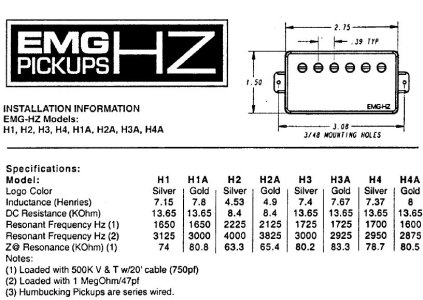Inflames626
New member
With the big push toward combining aspects of passive and active pickups in the gear world over the last 10-15 years or so, I'm wondering why people tend to hold their noses at the EMG HZ line. I think it does a pretty good job of combining aspects of active EMGs with the benefits of a passive pickup.
Like most kids in the 90s, I grew up playing the 60/81 combo, mainly due to Metallica. When the 18 volt mod came along, I tried that. I now use the 24 Volt Mod.
I've recorded tracks with EMG HZs though, mainly the HZ3 and HZ4, and have found them perfectly good pickups.
I would say for people who like the overall tone of the 60/81 but want aspects of a passive pickup (more dynamics, softer transients, less compression, etc.) they should start with the HZ line.
In addition, you get flexibility that the 60/81 doesn't offer, like being able to wire the HZs in various ways. You would need an 81tw/89tw to get this with actives. I don't think the 60 even has a split option. The HZ3 would give you that.
The funny thing is, I think the HZs kind of hurt active EMGs in the sense that you realize that the active preamp doesn't add all that much to the sound. This is because the HZ4 is the 81 without the active preamp.
I often found myself wondering, "Why am I fooling with 2 9 volt batteries when an HZ4 gets me 90% of the 81 sound along with some benefits of a passive pickup?"
My guess is the hate for the HZ is because if I remember correctly for a while HZs were sold with cheaper guitars and were retailed at a lower price point. This combined with their not being active made people think they were an inferior pickup to the active line.
These days in my 40s I'm over any kind of fascination with output or any kind of special technology. I try everything with an open mind and, if I like it, I keep it.
So, I think HZs are pretty good pickups. What do you guys think?
Like most kids in the 90s, I grew up playing the 60/81 combo, mainly due to Metallica. When the 18 volt mod came along, I tried that. I now use the 24 Volt Mod.
I've recorded tracks with EMG HZs though, mainly the HZ3 and HZ4, and have found them perfectly good pickups.
I would say for people who like the overall tone of the 60/81 but want aspects of a passive pickup (more dynamics, softer transients, less compression, etc.) they should start with the HZ line.
In addition, you get flexibility that the 60/81 doesn't offer, like being able to wire the HZs in various ways. You would need an 81tw/89tw to get this with actives. I don't think the 60 even has a split option. The HZ3 would give you that.
The funny thing is, I think the HZs kind of hurt active EMGs in the sense that you realize that the active preamp doesn't add all that much to the sound. This is because the HZ4 is the 81 without the active preamp.
I often found myself wondering, "Why am I fooling with 2 9 volt batteries when an HZ4 gets me 90% of the 81 sound along with some benefits of a passive pickup?"
My guess is the hate for the HZ is because if I remember correctly for a while HZs were sold with cheaper guitars and were retailed at a lower price point. This combined with their not being active made people think they were an inferior pickup to the active line.
These days in my 40s I'm over any kind of fascination with output or any kind of special technology. I try everything with an open mind and, if I like it, I keep it.
So, I think HZs are pretty good pickups. What do you guys think?
Last edited:

